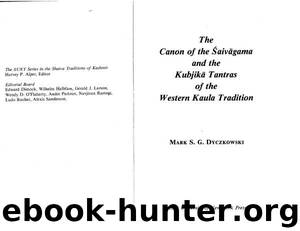Mandalas and Yantras in the Hindu Traditions by GUDRUN BUHNEMANN

Author:GUDRUN BUHNEMANN
Language: eng
Format: epub
Tags: Mandala; Yantra
[This is] the wine which imparts boldness to the words of lovers and frees them from fear while making love; the wine in which all the deities [of consciousness] who reside in the shade of the tree of the Kali age and practice mystic union {cakracarya) gladly abide; the wine which here [in Kashmir] bestows first pleasure then liberation. (TA, 37/44).
But not all thought so highly of these practices. We know that bans were
Notes
imposed and practising Kauias ostracized. Some, such as the satirist Ksemendra, who lived in Kashmir at the time, considered Kaula ritual and practice to be merely a source of moral corruption and an excuse for licence. See my Doctrine of Vibration, vol I SUNY Press, Albany, 1987, chapter 1.
26. For definitions of the word 'Tantra" see Tantra in Bengal: A Study in Its Origins, Development and Influence by S. C. Banerji, Naya Prakash, Calcutta 1978, pp. 1-3.
27. Renou remarks that the later Tantric texts Woodroffe studied that "describe the worship of the great Goddess" are called "Tantras" rather than "Agamas" (preface to SSP, vol. I, p. 1), Brunner notes, however, that in the early Siddhantagamic context the terms "Agama" and "Tantra"are synonymous (ibid., intro. p. iv.). Thus we find the following definition of Tantra, which has been repeated frequently throughout the centuries in a wide variety of Tantric scriptures, in the Kamikagama also, This must be one of the earliest citations of this definition:
tanoti vipulan arthams tattvamantrasamasritan | tranam ca kurute yasmat tantram ityabhidhlyate j
(P.M., 1/29),
28. Thus, Abhinavagupta, in the course of discussing one of the basic principles of Kaula doctrine, namely, that purity or impurity is not an inherent quality of things but a mentalprojection which must be overcome along with all other thought-constructs to achieve the pure conscious state of liberation says that: "such was also (the insight of) the ancient sages (muni) by virtue of their state free of thought-constructs but who, in order not to disrupt the order of the world, concealed it," (TA, 4/243b-4a)>
29. R. C. Hazra writes: "At the time the chapters on vows, worship etc. first began to be included in the Puranas, the Tantric elements were eliminated as far as possible." Studies in the Puranic Records on Hindu Rites and Customs, Motilal Banarsidass, 2nd edition, Delhi, 1975, p. 260. According to Hazra the additions made to the Puranas prior to the ninth century were largely free of Tantric influence. From about the beginning of the ninth century the authority of the Tantras came to be gradually recognized by the Puranas and so Tantric rituals were increasingly incorporated into them (ibid., pp. 260-2).
30. See, for example, Hazra p. 119,
31. Schoterman has published a study of these chapters in an article entitled: A Link between Puranaand Tantra: Agnipurana 143-147 in ZDMO Supplement IV, Wiesbaden, 1980.
32. TA., 28/407a.
33. Bhairava addresses the goddess in this way in the Niiisancaratantra. Copies of this text are indeed rare; I know only of one MS, namely, NA, no. 1/1606 (incomplete),
34. TA., 37/l(M2a.
35. We see in the
Download
This site does not store any files on its server. We only index and link to content provided by other sites. Please contact the content providers to delete copyright contents if any and email us, we'll remove relevant links or contents immediately.
Fingersmith by Sarah Waters(2406)
Kundalini by Gopi Krishna(2094)
Wheels of Life by Anodea Judith(1922)
The Bhagavad Gita by Bibek Debroy(1867)
Indian Mythology by Devdutt Pattanaik(1856)
The Yoga of Jesus: Understanding the Hidden Teachings of the Gospels by Paramahansa Yogananda(1752)
Autobiography of a Yogi (Complete Edition) by Yogananda Paramahansa(1739)
The Man from the Egg by Sudha Murty(1683)
Chakra Mantra Magick by Kadmon Baal(1589)
The Book of Secrets: 112 Meditations to Discover the Mystery Within by Osho(1588)
The Sparsholt Affair by Alan Hollinghurst(1509)
Avatar of Night by Tal Brooke(1451)
Sparks of Divinity by B. K. S. Iyengar(1450)
Karma-Yoga and Bhakti-Yoga by Swami Vivekananda(1437)
Gandhi by Ramachandra Guha(1435)
The Bhagavad Gita (Classics of Indian Spirituality) by Eknath Easwaran(1418)
The Spiritual Teaching of Ramana Maharshi by Ramana Maharshi(1373)
Hinduism: A Very Short Introduction (Very Short Introductions) by Knott Kim(1314)
Skanda Purana (Great Epics of India: Puranas Book 13) by Bibek Debroy & Dipavali Debroy(1309)
